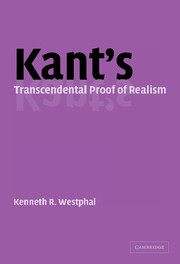Book contents
- Frontmatter
- Contents
- Acknowledgments
- List of abbreviations
- Introduction
- 1 Kant's methods: transcendental and epistemic reflection
- 2 The metaphysics of Kant's transcendental idealism
- 3 Transcendental affinity
- 4 The gap in Kant's Critique of Pure Reason
- 5 Kant's dynamic misconstructions
- 6 Kant's metaphysical proof of the Law of Inertia
- 7 Three Kantian insights
- Appendix
- Bibliography
- Index of names
- Index of subjects
1 - Kant's methods: transcendental and epistemic reflection
Published online by Cambridge University Press: 06 November 2009
- Frontmatter
- Contents
- Acknowledgments
- List of abbreviations
- Introduction
- 1 Kant's methods: transcendental and epistemic reflection
- 2 The metaphysics of Kant's transcendental idealism
- 3 Transcendental affinity
- 4 The gap in Kant's Critique of Pure Reason
- 5 Kant's dynamic misconstructions
- 6 Kant's metaphysical proof of the Law of Inertia
- 7 Three Kantian insights
- Appendix
- Bibliography
- Index of names
- Index of subjects
Summary
EPISTEMIC REFLECTION IN KANT'S CRITIQUE OF PURE REASON
Kant's non-Cartesian philosophy of mind
Kant insisted that the problems addressed by the first Critique can only be resolved by a “changed method of thinking” (Bxviii). He introduces this thought in connection with transcendental idealism. However, Kant's epistemology, his transcendental investigation of human cognition, likewise involves a “changed method of thinking.” Kant based his epistemological arguments on an inventory of our basic cognitive capacities to employ our forms of intuition and our forms of judgment (A66/B91, B145–6; O'Neill 1992). One way to put the key issue this raises is whether Kant's view, that “to know what one's inner states are like is to make judgments of certain kinds,” is an insight or is just another philosophical view. Kant proposes a non-Cartesian philosophy of mind by maintaining that our understanding can “only think,” that is, connect representations, whereas our sensibility can only provide, but not connect, representations (B130, 134–5, 145). If that is so, and if indeed our sensibility is only receptive, a mere susceptibility to stimulation by things distinct from us (A19–21/B33–5, A50–2/B74–6), then “inner experience” cannot have Cartesian primacy over “outer experience.”
Somewhat more fully, Kant's non-Cartesian philosophy of mind involves six theses:
Our senses are passive (A19–21/B33–5, A50–2/B74–6; 3:49–51, 74–6);
Sensations are caused by something other than us, but this causal relation does not suffice for sensations to represent their causes (sensationism; George 1981);
Our senses cannot combine or provide any representation of combination among our sensations (B130);
Our understanding “can only think,” that is, can only combine representations in judgments (B135, 145);
[…]
- Type
- Chapter
- Information
- Kant's Transcendental Proof of Realism , pp. 12 - 35Publisher: Cambridge University PressPrint publication year: 2004



